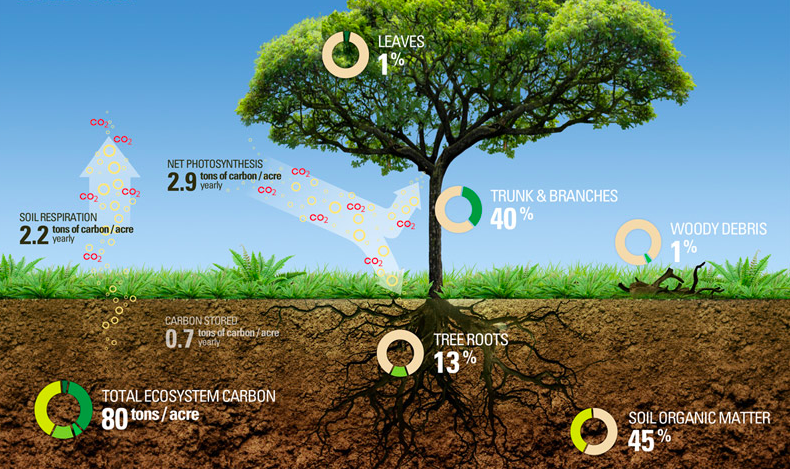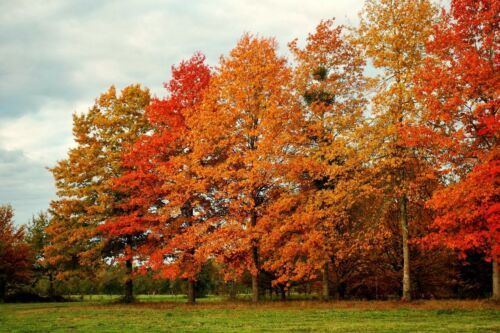Can planting trees save the planet?
Trees absorb atmospheric carbon dioxide, sequester the carbon, and produce oxygen. A new study says we’d have to plant billions more to slow global warming. (Image via Tree Hugger)
I’ve just finished reading two books that dwell on how woody perennials feel and communicate, and I’ve been pretty tree-obsessed since. The Overstory, by Richard Power, and The Hidden Life of Trees, by Peter Wohlleben both describe how extraordinary ordinary trees are. Trees warn each other of impending danger, share nutrients with other trees in need, and work together to build stronger communities. As if this weren’t remarkable enough, trees share essentials, like food and oxygen, with us, and mitigate climate change by drawing down and storing carbon dioxide.
Long story short, we don’t deserve trees.
Aside from inspiring immense levels of appreciation for these majestic plants, both books prompted me to revisit the conventional wisdom I grew up with: Planting trees can save the planet.
Can they really? More than half the carbon spewed into the atmosphere by the burning of fossil fuels has been emitted in only the past three decades, just shy of my entire lifetime. Given the enormous increase in the amount of greenhouse gases being released, can planting trees slow global warming?
Trees store more carbon than fellow photosynthesizers, thanks to their above ground woody mass and extensive root systems underground. While most all trees are carbon champions, dense wood and large canopies make for particularly good sequestration. (Image via TreeSpirit Project)
An answer comes from a group of Swiss and Italian researchers who published a study in Science in July. They concluded that the Earth has about 2 billion acres of unused land, enough to support the planting of 500 billion trees. Doing so could capture 205 gigatons of carbon, or about two-thirds the amount humans have dumped into the atmosphere since the beginning of the Industrial Revolution.
Good news, right? Except consider the logistics of such a proposal. What might it take to round up all those vacant lots, stripped fields, and grazing lands, and replant them? Critics noted the study failed to take into account the magnitude of the undertaking and critical variables, such as cost and land ownership.
Shortly after the Science study was released, the Intergovernmental Panel on Climate Change report (IPCC) issued its own report on land management and climate change. It too laid partial blame on deforestation for accelerating the rate of climate change. Every year 15 billion trees are chopped down in the interest of agriculture and other forms of industrialization. Worth noting: Amazon deforestation shot up by 278 percent over the past year, resulting in the destruction of another 870 square miles. (Thank you, President Jair Bolsonaro.)
Peatlands cover around three percent of our planet, but store twice as much carbon as all the world’s forests. Unfortunately, most people don’t know about this incredible carbon sucking potential, which has allowed peatlands to be exploited for mining and agriculture. (Image via UN Environment Programme)
The IPCC report also noted that even more effective than forests at locking down carbon are peatlands and marshes. They represent about 42 percent of all carbon stored, and right now they’re being drained for agricultural and industrial reasons.
Other critics point out it takes trees years to reach full carbon-sucking maturity. “Don’t fool yourself into thinking this is any kind of free ticket,” writes Kevin Drum of Mother Jones. “We still have to figure out a way to reduce actual emissions by a huge amount if we want to avoid planetary catastrophe.”
Study co-author Jean-Francois Bastin agrees. Heroic tree planting would only “buy us time,” he says. But it’s time we could use to stop emitting greenhouse gases, the real solution to climate change.
Planting trees so it counts
Planting more trees isn’t a solution, but it is something, especially if you take steps to make the most of the act.
Medium growth trees, like the pin oak, absorb more carbon than fast-growing trees. (Image via Bonanza)
Plant it now. A popular Chinese proverb goes: “The best time to plant a tree was 20 years ago. The second best time is now.” The same can be said of carbon sequestration. A tree must live 10 to 20 years to have a meaningful effect on the environment, according to Peter Del Tredici, senior research scientist emeritus at the Arnold Arboretum at Harvard University. Because of this, medium growth trees, like the pin oak, absorb more carbon than fast growing, shorter lived trees, such as poplars.
Pick one that suits your local climate. This may be too obvious to even include, but selecting a tree suited to your climate means minimal maintenance and a greater chance of thriving. So visit your local gardening center for suggestions, or try this cool online tool I found: Arbor Day’s Best Tree Finder determines the optimal tree for any environment. After inputting my criteria—a slow growing sapling that favors loamy soil, partial shade, and hardiness zone 8-10—I learned that Black Tupelo, Red Buckeye, and Kousa Dogwood are my best bets.
Hardiness Zones divide the United States and Canada into 11 zones based on average annual minimum temperature. Though local variations like moisture and wind can effect the growth of certain plants, knowing your hardiness zone will help you select a tree that’s viable in your zone’s temperature extremes (image via Arbor Day)
Plant it on the south side of your home, if possible. Or anywhere it can screen light.
Deciduous trees can screen 70 to 90 percent of summer sun, while still allowing in cool breezes. And communities with well-shaded streets can be 6 to 10 degrees cooler than those without street trees, which, in turn, reduces the heat-island effect and local energy needs, according to the U.S. Forest Service Center for Urban Forest Research.
When they lose their leaves in the winter, warming sun rays still pass through to help keep your home warm. Overall, strategically placed trees and shrubs can reduce household energy use by 25 percent, says the U.S. Department of Energy.
Support organizations that plant trees. From major cities to distant rainforests, organizations like The Nature Conservancy, International Tree Foundation, and One Tree Planted are planting trees across the globe. I’ve just signed up to become a member of all of them. Why not.
Ari Smolin is a Stone Pier Press News Fellow based in Los Angeles, CA.













